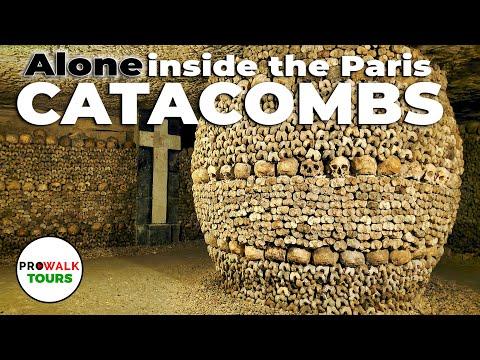I descended into the Paris Catacombs, a labyrinth beneath the city known for its eerie stillness and historical weight. The narrow passageway swallowed me whole, as though I was being drawn into an ancient, forgotten world. The dim, flickering light of my lantern cast long, haunting shadows on the walls, creating an unsettling dance of darkness and light.
The cool, damp air clung to my skin, and the faint smell of earth and decay filled my nostrils. My footsteps echoed softly against the stone, each step amplifying the silence that pressed heavily around me. I turned a corner and found myself in a chamber where the walls were lined with countless bones, meticulously arranged in patterns that spoke of both reverence and macabre artistry.
The bones were not merely scattered but were thoughtfully organized into arches, columns, and even intricate designs that hinted at the aesthetic sensibilities of those who had arranged them. I couldn’t help but feel a sense of profound respect mixed with a shiver of unease. Here, beneath the bustling streets of Paris, was a silent testament to a different era.
I wandered deeper, the passageways twisting and turning in ways that seemed almost deliberate, as if the catacombs themselves were trying to disorient intruders. Each new section revealed a different arrangement of bones, from simple stacks to elaborate friezes. The skulls stared out at me, their empty eye sockets like silent witnesses to the passage of time.
As I ventured further, I stumbled upon a chamber that was different from the others. It was a small, circular room with a high, domed ceiling. The walls here were adorned with a strange, almost delicate pattern—rows of bones laid out in concentric circles, creating a mesmerizing, if morbid, design. The pattern was so intricate that it almost felt like a piece of forgotten art, a secret message left for those who would come after.
The deeper I went, the more I felt the weight of history pressing down on me. The catacombs had originally been quarries, a fact that seemed almost ironic now, given their current state. The bones that filled these tunnels had been moved here in the late 18th century when Parisian cemeteries became overcrowded. The bones were transferred to this underground ossuary, and what was once a place of death became a place of remembrance.
I paused for a moment to take in the surreal atmosphere. The silence was profound, broken only by the occasional drip of water from the ceiling or the distant rustling of what I hoped was just a stray rat. I found it strangely comforting, this profound quiet. It was a reminder of the vastness of time and the insignificance of individual lives within it.
Continuing on, I noticed a small, unassuming alcove tucked away in one of the corners. Inside, I found a simple wooden cross, seemingly out of place amidst the skeletal decor. The cross was worn and weathered, a stark contrast to the meticulous arrangement of bones around it. It was a poignant reminder of the spiritual aspects of death, a lone symbol of faith in a place where faith seemed almost irrelevant.
As I moved away from the alcove, I encountered a series of inscriptions carved into the walls. They were in Latin, a language I only vaguely understood, but their meaning was clear enough. They spoke of mortality, of the fleeting nature of life, and of the eternal rest that awaited everyone. It was as if the catacombs were a grand, unspoken sermon on the impermanence of human existence.
The more I explored, the more I felt the catacombs revealing themselves to me, layer by layer. It was as if each bone, each arrangement, was part of a larger narrative, one that spoke of a city’s complex relationship with death and memory. The catacombs were not merely a place of storage for the dead; they were a reflection of how Paris itself had grappled with the concepts of life and death throughout its history.
Eventually, I reached a point where the catacombs seemed to narrow, the tunnels growing tighter and more claustrophobic. My lantern flickered as if protesting against the darkness that seemed to close in on me. I paused, taking a deep breath and gathering my courage before pushing on.
At last, I emerged into a wider chamber that seemed to mark the end of my journey through this underground maze. The walls here were lined with dusty old maps and old, forgotten artifacts, remnants of a time when these tunnels were more than just a graveyard. They spoke of an era when explorers and adventurers wandered these passages, perhaps seeking something that even now remains elusive.
I stood there for a while, soaking in the atmosphere of the room. The catacombs, with their silent and solemn beauty, had left an indelible impression on me. They were a place where history, art, and mortality converged in a way that was both haunting and profound.
Finally, with a mixture of relief and melancholy, I began my ascent back to the surface. As I climbed the narrow, winding staircase leading out of the catacombs, I felt a sense of bittersweet departure. The catacombs had given me a glimpse into a hidden world, a reminder of the ephemeral nature of life, and a connection to the countless souls who had come before me. As the sunlight hit my face, I carried with me the echoes of that subterranean silence and the weight of history that lingered in the darkened corridors below.
